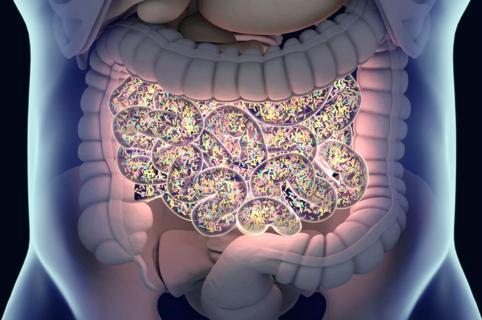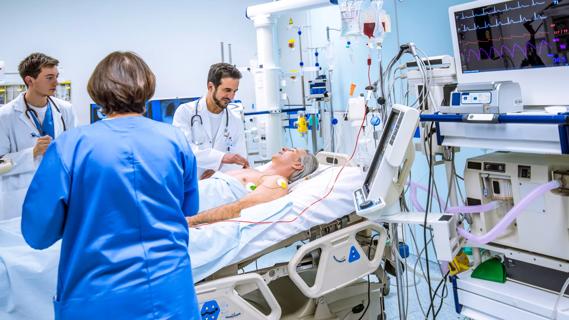Collaborative involving Cleveland Clinic investigators focuses on antiviral drug development

Two Cleveland Clinic Lerner Research Institute scientists are part of a national consortium developing new antiviral drugs to combat COVID-19 and prevent future pandemics.
Advertisement
Cleveland Clinic is a non-profit academic medical center. Advertising on our site helps support our mission. We do not endorse non-Cleveland Clinic products or services. Policy
Jae Jung, PhD, Director of the Global Center for Pathogen & Human Health Research, and Shaun Stauffer, PhD, Director of the Center for Therapeutics Discovery, are collaborating with a multidisciplinary team based at California’s Scripps Research with the goal of creating drugs to target viruses with high pandemic potential — specifically, coronaviruses and tick-borne viruses.
Scripps Research recently was awarded $67 million by the National Institute of Allergy and Infectious Diseases (NIAID) to create the Center for Antiviral Medicines and Pandemic Preparedness (CAMPP), with Drs. Jung and Stauffer receiving a combined $3.28 million for their projects. “The scientific findings that will be discovered through the research enabled by this grant have the potential to accelerate our response to future pandemics,” says Serpil Erzurum, MD, Cleveland Clinic’s Chief Research and Academic Officer. “Drs. Stauffer and Jung’s participation in this collaboration of the nation’s leading research experts represents Cleveland Clinic’s growing investment in studying viral pathogens to prepare for the next public health threat.”
Dr. Stauffer and his team will study a promising COVID-19 drug target derived from the SARS-CoV2 virus, called 3CLpro (3-chymotrypsin-like protease).
Plaxlovid, the only 3CLpro antiviral drug currently approved by the Food and Drug Administration to treat COVID-19, is a combination drug that requires a liver enzyme inhibitor to help boost its effectiveness.
“As a result, drug-drug interactions are a concern, and some people are altogether excluded from receiving Plaxlovid,” says Dr. Stauffer. “Due to this limitation, as well as concerns of resistance and future SARS-CoV2 variants, the identification of improved stand-alone 3CLpro therapies is needed.”
Advertisement
The team is pursuing new, more efficacious drug molecules and has found several promising compounds that will be further studied at Cleveland Clinic’s Florida Research and Innovation Center.
“We’re racing to discover better antivirals for the treatment of both current and future variants of SARS-CoV2 and other coronaviruses,” says Dr. Stauffer. “The molecules at our disposal have the ability to be taken orally, with enhanced metabolism profiles, and have increased overall potency.”
Multidisciplinary collaboration with the Scripps Research team through this NIAID grant increases the potential for rapid innovations, ultimately helping close the gap between translational research and clinical drug trials.
Dr. Jung’s research will build on his previous studies involving severe fever with thrombocytopenia syndrome virus (SFTSV), an emerging tick-borne phlebovirus with a 20-30% mortality rate. SFTSV was first identified in China in 2009. The World Health Organization has designated SFTSV as a prioritized pathogen for research due to its potential to cause widespread disease. The virus is spread by an infected longhorn tick indigenous to Asia (Haemaphysalis longicornis). H. longicornis has been documented in multiple U.S. states since its initial detection in 2017. No SFTSV vaccines or therapies currently exist.
“SFTSV initiates viral mRNA synthesis through a ‘cap-stealing’ mechanism in which capped host mRNAs are cleaved by SFTSV and the resulting fragments are used to initiate infection,” says Dr. Jung. “Our goal is to discover a therapeutic drug that blocks the SFTSV cap-stealing activity.”
Advertisement
These research projects, made possible by the Global Center for Pathogen & Human Health Research, are just the beginning of a global infectious disease program at Cleveland Clinic. The center has received $200 million in funding from the State of Ohio and JobsOhio, the state’s economic development corporation, along with a $300 million investment by Cleveland Clinic.
Headquartered in Cleveland and spanning Cleveland Clinic’s international footprint in Florida, London and Abu Dhabi, the center is bringing together a research team focused on broadening the understanding of viral pathogens, virus-induced cancers, genomics, immunology and immunotherapies. The state support will position the center to thrive not only as a research catalyst but a commercial force that will drive new products, jobs and economic development in Ohio.
As part of the new Cleveland Innovation District, the center is anticipated to create an estimated 1,000 new jobs at Cleveland Clinic and an additional 7,500 jobs in Ohio. The project represents the largest economic development investment of its kind in Northeast Ohio.
“The Global Center for Pathogen Research & Human Health will be a command center to help solve deadly threats to our health, economy and communities,” says Dr. Erzurum. “The unparalleled investment in the center will drive workforce development while leveraging Cleveland Clinic’s research infrastructure to study pathogens and the immune system in novel ways to develop new diagnostic tests, vaccines and treatments.”
Advertisement
Advertisement

First full characterization of kidney microbiome unlocks potential to prevent kidney stones

Researchers identify potential path to retaining chemo sensitivity

Large-scale joint study links elevated TMAO blood levels and chronic kidney disease risk over time

Investigators are developing a deep learning model to predict health outcomes in ICUs.

Preclinical work promises large-scale data with minimal bias to inform development of clinical tests

Cleveland Clinic researchers pursue answers on basic science and clinical fronts

Study suggests sex-specific pathways show potential for sex-specific therapeutic approaches

Cleveland Clinic launches Quantum Innovation Catalyzer Program to help start-up companies access advanced research technology